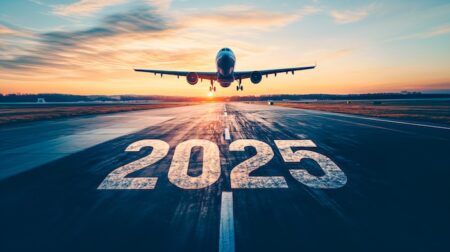A recent McKinsey report has cast a spotlight on the aviation industry’s future. And as the use of AI and automation accelerates across the sector, I must issue a stark warning: unless these technologies are intentionally embedded into learning and development (L&D) and core business processes, the aviation industry risks entering a dangerous era of deskilling.
AI will no doubt boost productivity, but it also threatens to erode something far more valuable: the edge, judgment, communication and critical thinking of humans. These are the very capabilities that front-line aviation staff need to navigate disruption, safeguard passengers, and create excellent customer experiences.
This view coincides with McKinsey’s excellent State of Aviation 2025 report, which highlights that organisational health, and not just operational efficiency, remains a key driver of sustained performance. Airlines that score well on measures such as strategic clarity, cross-functional collaboration and employee motivation, are more likely to generate a positive return on invested capital (ROIC). Yet this health is precisely what is at risk if AI is rolled out without intention.
Emerging research supports this concern. A recent study in Humanities & Social Sciences Communications found that 68.9% of participants reported increased laziness and reliance on AI tools, diminishing their motivation to learn and engage deeply with tasks. Over time, such disengagement chips away at core human competencies – including decision making and independent problem-solving.
In fact, it could be argued that AI is going to deskill people no matter what, so the aim should be to reframe the role of people in the passenger experience, and also take a fresh look at that passenger experience.
What aviation can learn from wider industry
Airlines are not alone in facing this paradox. In sectors like telecoms and utilities, rapid automation promised better efficiency and lower costs, but has this been the case? Yes, systems became smarter, but people didn’t, and when the system fails as it inevitably does, the human support behind it isn’t equipped to take over.
In aviation, the stakes are higher. A chatbot can’t calm an anxious passenger whose flight has been cancelled, and an algorithm can’t empathise with a stranded family. And AI won’t fix the damaged reputation such disruptions can lead to. While predictive maintenance can prevent technical faults, it can’t anticipate every variable that arises during an operational disruption. What is needed isn’t just automation – it’s human intelligence, with employees learning to fix problems.
Across industries such as retail and hospitality, AI isn’t replacing human service, it is empowering it. AI can enhance every touchpoint, from discovering a product, through to aftersales care.
Likewise banking is on the front foot in improving customer experience, as business moves away from the high street, with NatWest partnering with OpenAI to enhance its ‘Cora’ digital assistant, delivering a 150% increase in customer satisfaction and reducing reliance on human advisors.
Customer experience begins with confidence
For the aviation industry, the rollout of AI is going to mean reimagining the travel experience from the ground up. The focus needs to be upon the experience of passengers, rather than the process of travel. Singapore Airlines uses predictive AI for in‑flight meal planning, aligning meal options with passenger preferences, which reduces waste and boosts passenger satisfaction.
If we consider security lanes, which are a necessary pain point of travel, they could largely be replaced by AI processes where passengers don’t need to interact with a human. And their experience could be enhanced by such a system.

AI is different to previous technological trends we have seen because it can replace multiple skilled and unskilled roles all at the same time. When you can get a desired outcome with a few prompts, where’s the journey? This is something the aviation industry is striving to tackle, because the journey starts as soon as a flight is booked. The challenge, however, is that for most the consumer experience isn’t a pleasurable one, with airports getting busier, and protocols becoming stricter and taking longer to navigate.
Aviation has one massive USP, though, and that is the speed of travel. Flying gets the passenger to their destination quickly, which brings us to Rory Sutherland who challenges efficiency over experience in public services, specifically the UK rail system, in his famous TED talk. He argues that you could spend £6 billion to make a train route 40 minutes quicker. Or you could spend £1 billion and put Wi-Fi on the trains and make the journey more enjoyable. Or even less – have models serving wine, and people might ask for the train to be slowed down.
Sutherland’s core argument is that intangible value – how people feel, perceive, and experience things – is massively undervalued by traditional models of economics and decision making. And it’s often cheaper, faster, and more effective to improve experiences than to change the product.
Customer service in aviation is ultimately a human experience, and the quality of that experience is directly linked to the confidence and capability of its people. For instance, the ground crew member who rebooks a connection, the pilot who makes an informed decision in mid-air, or the call centre colleague who deals with an irate traveller calmly and effectively.
These moments don’t just reflect soft skills, they reflect judgment under pressure, often developed over years. Without a focused and forward-looking L&D strategy, and human-centred design, these skills risk being eroded.
Time for a learning reset
AI is accelerating, and L&D must accelerate with it or we will be left relying on training models built for a pre-digital age, with passive learning, siloed modules, and one-size-fits-all certifications. It seems we have reached a pivotal stage with AI, and as we sit here today it is the worst it’s ever going to be. Every industry is on a learning curve right now, but that curve should not grow steeper or further than the pace of human involvement, or L&D.
Airlines are working hard on this problem, and are fundamentally rethinking how they onboard, upskill and empower their staff, but learning ecosystems should evolve alongside the technology, ensuring that employees are equipped not just to operate systems, but to truly understand them.
AI should not be used to deskill the workforce, but to develop it by identifying performance gaps and enabling personalised learning pathways that help people grow with the tools they use. It can support learning just as much as it supports operations, but only if it is embedded into a broader organisational culture of development.
With the right approach, AI has the potential to reimagine the experience of travel. That means using technology to remove friction where it doesn’t add value, and empowering people where it does. It means less queuing and more care, less stress and more clarity, and fewer processes and more experiences.
But this vision won’t be achieved through automation alone. It will require the aviation sector not just to look at what AI can replace, but at what it can enable – and that starts with people, because L&D is not a support function. L&D is the foundation for ensuring that technology is aligned with an organisation’s people, and that its people are aligned with customers.





